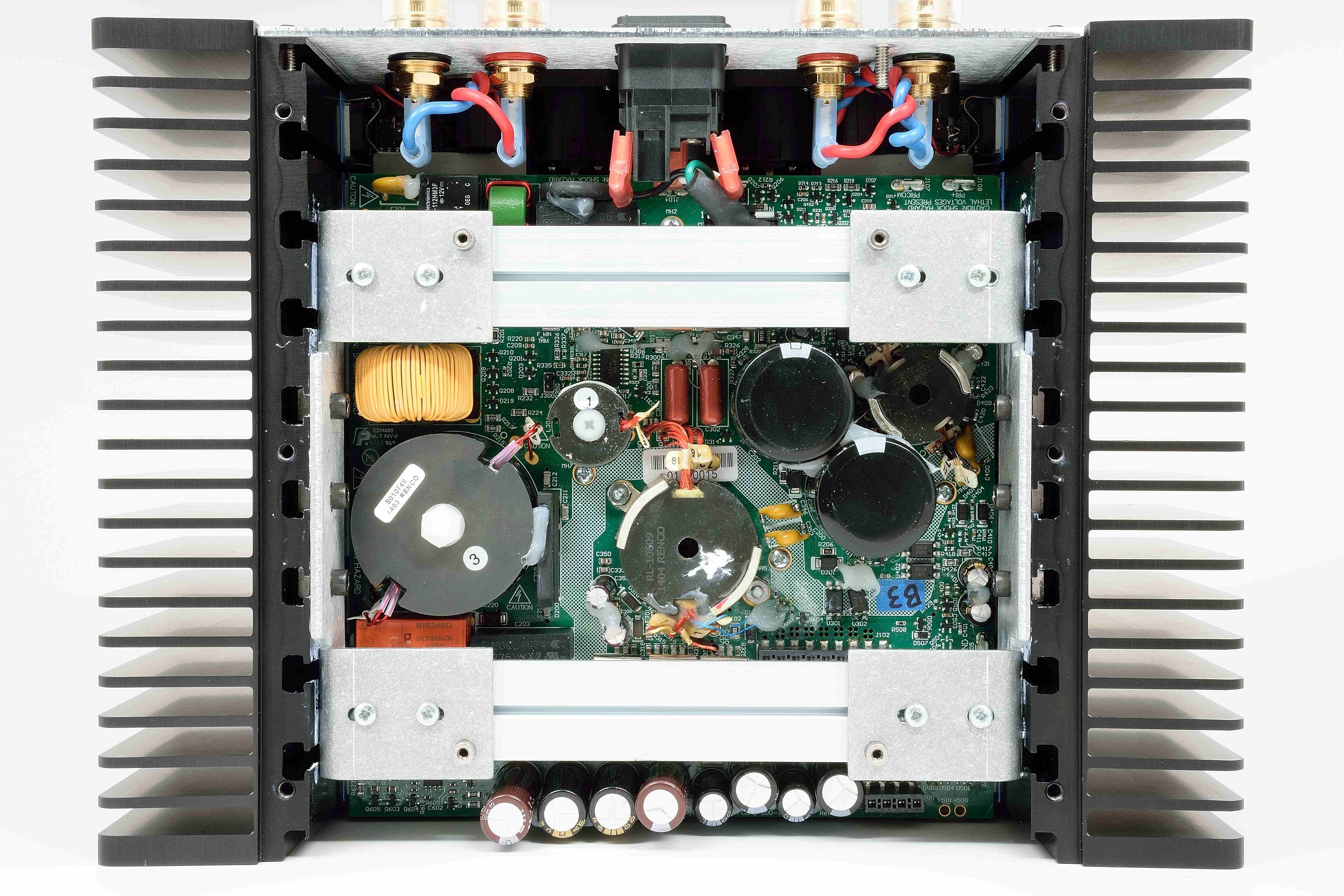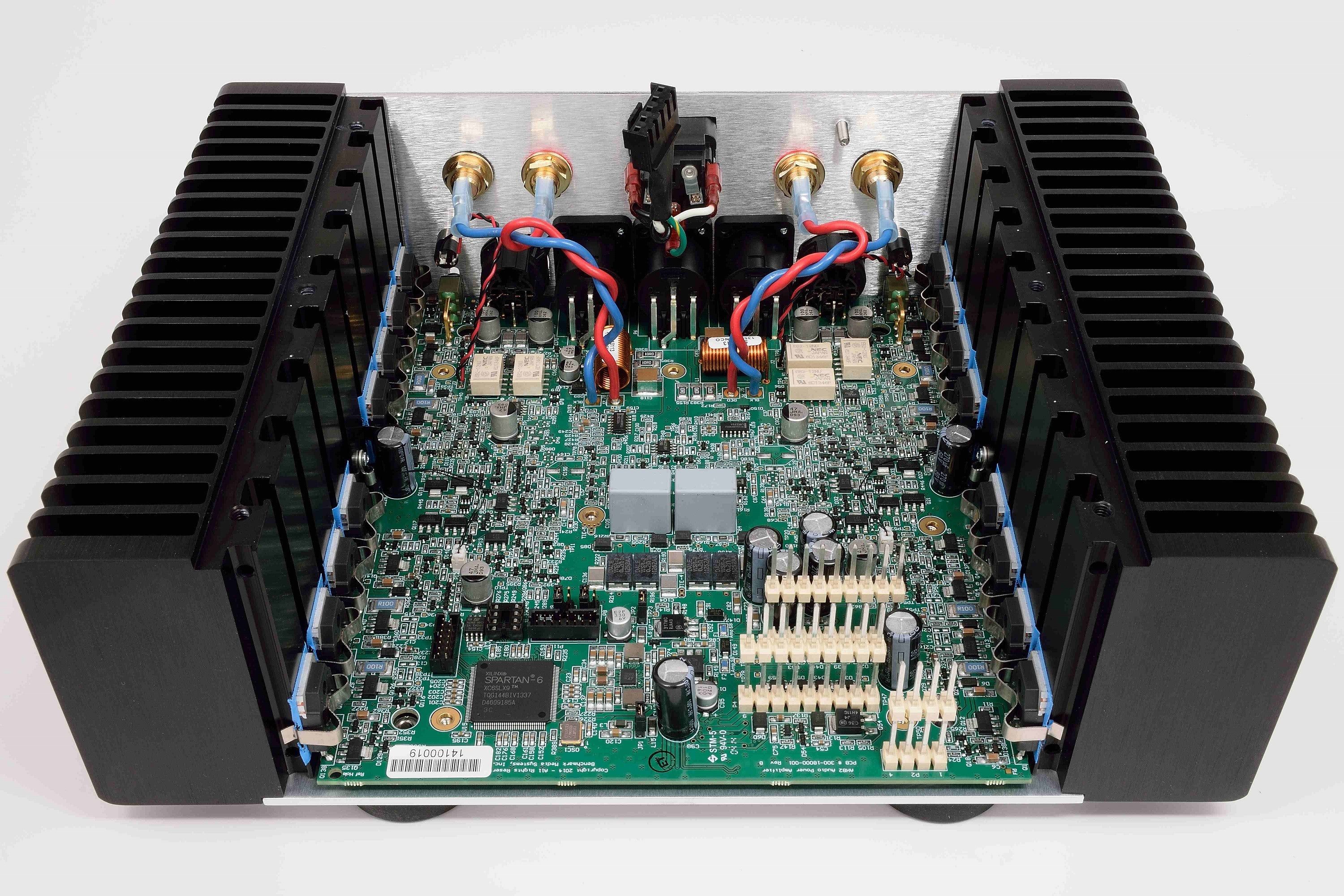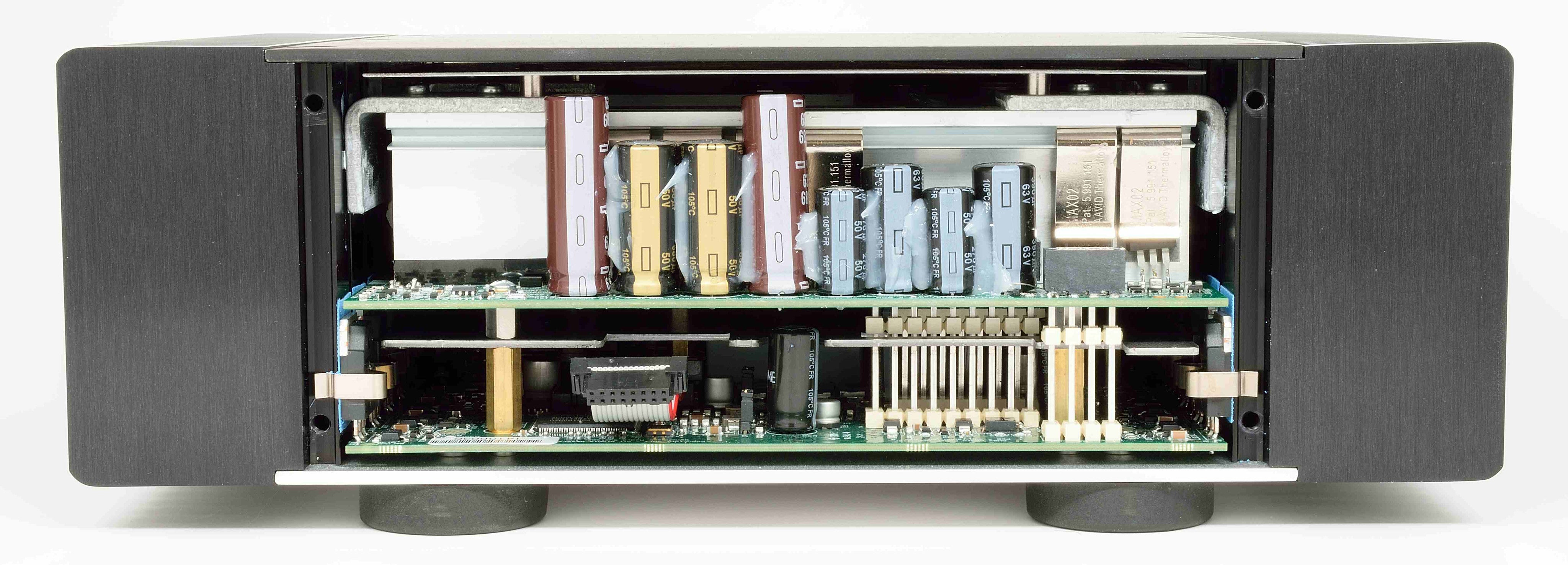Buy one component and save 10% on up to 2 cables. Buy 2 components and get 4 free cables. Free shipping on USA orders over $700.
Buy one component and save 10% on up to 2 cables. Buy 2 components and get 4 free cables. Free shipping on USA orders over $700.
The AHB2 - A Radical Approach to Audio Power Amplification
by John Siau July 30, 2014

The Benchmark AHB2 is a radically different audio power amplifier. It delivers the lowest distortion and lowest noise of any commercially available power amplifier. The THD+N and SNR specifications are 20 dB better than many high-end hi-fi power amplifiers. The unique high-efficiency design delivers hundreds of watts from a relatively small, passively cooled chassis.
The AHB2 is Not a Class-D Amplifier (And Here is Why)
It seems like everyone is building class-D amplifiers, and some of them look very good on paper until you take a deeper dive into the specifications. Many class-D deficiencies are obscured by the fact that 20 kHz brick-wall filters are always used when measuring class-D amplifiers. These class-D test filters improve the measured performance, but they are not present when you connect a class-D amplifier to your speakers. Tweeters are not ideal low-pass filters and the class-D ultrasonic switching noise can produce audible effects when it interacts with the tweeters.
Class-D amplifiers also suffer from poor THD performance at input frequencies above 1 kHz. Some of the newest Class-D amplifiers have impressive specifications at 1 kHz, when measured through a brick-wall 20 kHz lowpass filter, but this performance quickly degrades at higher audio input frequencies. It also degrades when driving low impedances and difficult reactive loads.
For these reasons, Benchmark does not believe that class-D amplifiers are the best choice for reference-level performance. Nevertheless, class-D amplifiers are a great choice for cost-sensitive applications.
AHB2 Design Goals
Our goal was to build an amplifier with a SNR that exceeded 130 dB while delivering full output power at a THD+N better than 0.0003% (-110 dB), with a noise-free bandwidth exceeding 200 kHz.
It was clear that our goals could not be achieved with class-D technology. It was also clear that we could not reach these goals with a traditional class-AB or class-A linear design. We would need to throw out all of the established "rules" for building power amplifiers and start from scratch. We would need to take a radical approach and question all of the existing rules. Looking back, it is surprising how many rules we broke.
A Radical Approach to Audio Power Amplification
The performance of the AHB2 would not have been achievable without taking a radical approach to power amplification. In many ways, the AHB2 is a complete 180 degree departure from traditional high-end amplifier designs.
- AHB™ Amplifier – This unique amplifier uses THX-patented AAA™ (Achromatic Audio Amplifier) technology to achieve high efficiency and vanishingly low distortion. The AHB2 combines class-H, and class-AB amplifier technologies with feed-forward error correction. Benchmark and THX collaborated to combine unique THX-technologies with Benchmark's uncompromising attention to performance and quality.
- Feed-Forward Error Correction - Each channel of the AHB2 is equipped with a main amplifier and an ultra-clean low-power auxiliary error-correction amplifier. The main class-AB amplifier provides the bulk of the power while the auxiliary amplifier provides a low-power error-correction signal. These amplifiers are combined to create a near perfect null of all distortion components. The THX-patented feed-forward error-correction system in the AHB2 is much more effective than traditional feedback error-correction systems. Distortion does not change with loading, and does not rise near maximum output. Difficult loads are driven with near-perfect clarity. Low-level musical details are delivered without the masking effects of crossover distortion. The AHB2 is virtually distortion free at low levels, at maximum output, and everywhere in between. Overall, the distortion produced by the AHB2 is so low, that it approaches or exceeds the measurement limits of some of the finest audio test systems.
- Error-Correction Amplifier - The error-correction amplifier is a small ultra-clean amplifier that feeds a correction signal forward to the main output. The main amplifier errors are measured, inverted, and buffered by the error-correction amplifier. The output of the correction amplifier is a high-precision mirror of the errors produced by the main class-AB amplifier.
- Low-Bias Class-AB Main Amplifier - Class-AB output stages always produce "crossover distortion" whenever the push-pull output drivers change state. Precise bias control is usually required to minimize this crossover distortion. Traditional feedback networks have difficulty correcting the transients caused by push-pull crossover transitions. However, the THX-patented feed-forward error-correction system has the speed and precision necessary to virtually eliminate all traces of crossover distortion. With this feed-forward system, bias currents have no significant impact on the distortion at the output of the amplifier. This topology provides the freedom to conserve power by setting unusually low bias currents. The AHB2 uses very low bias currents but achieves vanishingly low distortion - even under heavy loading.
- Class-H Tracking Rails - Tracking power supply rails (class-H), can significantly improve the efficiency of a class-AB amplifier. But, the improved efficiency provided by this topology usually comes at the cost of increased distortion. For this reason, there are very few amplifiers that use multiple supply rails. In a traditional feedback design, every rail switch point adds another layer of crossover distortion. In contrast, the feed-forward error correction used in the AHB2 is so effective that multiple rails can be added without incurring a distortion penalty.
- Low Gain – The AHB2 has a low gain setting that optimizes the gain structure of professional monitoring systems. Maximum rated output is reached at an input signal level of 22 dBu. This places the upstream equipment in an ideal operating range to maximize the SNR of the monitoring chain. Most power amplifiers have far too much gain, and this degrades noise performance of the overall system. The AHB2 has an ultra low-noise input amplifier with two gain boost settings that can be enabled to allow direct interfacing with Hi-Fi components that usually operate at significantly lower signal output levels.
- Passive Cooling – The sonic performance of the AHB2 would be impossible to appreciate if it had a motor-driven fan. There are no noise-generating fans to detract from the total silence of the AHB2. Experience every detail of your favorite recordings without the masking effects of fan noise.
- Resonant Switch-Mode Power Supply – Most high-end power amplifiers use unregulated linear power supplies. The conventional wisdom is that linear supplies are electrically quieter than switching supplies. Benchmark's research shows that this is a myth. Linear supplies have transformers that operate at the AC mains frequency. The problem with these 50 to 60 Hz transformers is that they must be very large in order to supply the required power. These large low-frequency transformers generate large stray magnetic fields that can interfere with other nearby devices, and with the amplifier itself. The noise performance of many traditional power amplifiers is limited by the amplitude of the AC line-related hum. This hum is often magnetically induced and is very hard to eliminate. To solve these problems, Benchmark now uses switching power supplies in all of its newer products. Switching frequencies are set well above the audio band. More importantly, the high switching frequency greatly reduces the size of the magnetic components and the magnitude of the stray magnetic fields. Resonant switching is used in the AHB2 to minimize switching noise. Resonant supplies switch at low voltage and low current and are much quieter than traditional switching supplies.
- Regulated Power Supply - Audio amplifiers usually use unregulated supplies. The theory is that the amplifier can produce higher peak output power for a given power supply size. Linear regulation would throw away power that could be delivered to the output devices. Benchmark's move to switching supplies changes the efficiency equations. Switching supplies can produce a regulated output without wasting power and without creating unwanted heat. A further advantage of regulation is that the output voltage is not a function of AC line voltage, prior audio content, or speaker loading. The switching supply in the AHB2 responds to bass frequencies, maintains a constant low-ripple output voltage, and delivers very predictable output power.
- Low Stored Energy - Most audio power amplifiers rely on a bank of large capacitors for energy storage. These capacitors remove some of the ripple produced by an unregulated linear supply, and help reduce supply sag in order to maintain a high output level immediately following musical peaks. Unfortunately, these capacitors also slow down the recovery from voltage sag due to peak loading. Benchmark's approach is to nearly eliminate all storage after the power supply. The power supply regulation takes the place of energy storage, responds quickly to peak loading, maintains very low ripple voltage, and provides immunity to AC line-voltage fluctuations.
- Digital Protection Systems - The AHB2 has a digital control system that monitors all of the critical functions in order to provide comprehensive protection from overload and fault conditions. The AHB2 includes circuits to detect temperature, current, voltage, distortion, DC offset, short circuits, and loss of audio.
- NL4 SpeakON Output Connectors - SpeakON connectors are well-accepted in high-power pro-audio applications, but are nearly unknown in high-end Hi-Fi applications. Our tests show that these robust connectors provide a much more reliable connection than the binding posts, spade lugs, pins, and banana plugs used with traditional Hi-Fi amplifiers. Our tests showed that non-locking banana plugs usually produce measurably higher distortion than NL4 connectors. Furthermore, the performance of spade lugs and locking banana plugs varied while the NL4 connectors consistently provided top performance. These connectors provide a very reliable, low-impedance connection. Furthermore, they are polarized and fully insulated to protect against short circuits, polarity reversals, and shock hazards. Benchmark recognizes that the Hi-Fi industry is slow to embrace new ideas, so we have provided traditional binding posts wired in parallel to the NL4 connectors. But, for the highest performance, we recommend using the NL4 connectors.
In summary, Benchmark has taken a radical approach to audio amplification, has leveraged two patented technologies (licensed from THX Ltd.), and has reversed many common practices. The result is an amplifier that is significantly quieter, cleaner, smaller, and more efficient than any traditional design. There is nothing ordinary about the Benchmark AHB2.
Top View Showing Ultra Low-Noise Power Supply (Resonant Switching Supply)

The power supply responds to audio peaks in real time and does not rely upon capacitive energy storage. The small capacitors at the bottom of this photo comprise most of the capacitance on the secondaries. This is a very small amount of capacitive storage for a power amplifier of this size. This is a radical departure from traditional designs. High-speed active regulation maintains constant DC voltages on all of the DC rails.
Top View Showing Linear Amplifier Board with Feed-Forward Error Correction

The bipolar power transistors are mounted directly to the heat sinks (8 transistors per channel). The mounting clips allow thermal expansion without stressing the transistor packages. There are no fans or vents in the chassis. The output transistors and power supply heat-sink bars place a uniform thermal load on the external heatsinks. The temperature differential between transistors is very small.
The large chip in the front is an FPGA. This device monitors output voltage, output current, output power, output distortion, and the temperatures of critical components. The FPGA will shut down the power supply, the amplifier board, or both, before a fault can cause damage to the amplifier or speakers.
The relays in the back control the gain of the balanced line-level inputs. There are no relays in the output path.
Front View of AHB2 With Faceplate Removed

From top to bottom:
- Top Cover
- Magnetic Shield
- Heat-Sink Bars
- Ultra Low-Noise Resonant-Switching Power Supply
- Magnetic Shield
- Linear Class-H Bipolar Amplifier with Feed-Forward Error Correction
- Base Plate
Also in Audio Application Notes

How Loud is the Distortion from Your Power Amplifier?
by John Siau August 08, 2025
Would you put a Washing Machine in your Listening Room?
If the answer is no, you may be surprised to discover that the distortion produced by your power amplifier may be louder than the noise produced by a major appliance.
Don't believe me? Take a look at Stereophile's test reports:
We selected 7 power amplifiers from Stereophile's top list of recommended amplifiers.
We took Stereophile's "THD+N vs. Power" plots for each, and replotted the data in a format that shows the loudness of the THD+N at the listening position.
The results are shocking!
Amplifier THD+N is louder than expected!
The distortion from your amplifier may be louder than a washing machine on the spin cycle, or it may be totally silent. How does yours perform? The answer is hidden in Stereophile's THD+N plots.
This application note reveals the hidden truth:
"The Distortion from your Power Amplifier may be Louder than a Washing Machine!"
I know, it sounds crazy, but this is what the measurements show!

Interpolator Overload Distortion
by John Siau November 20, 2024
Most digital playback devices include digital interpolators. These interpolators increase the sample rate of the incoming audio to improve the performance of the playback system. Interpolators are essential in oversampled sigma-delta D/A converters, and in sample rate converters. In general, interpolators have vastly improved the performance of audio D/A converters by eliminating the need for analog brick wall filters. Nevertheless, digital interpolators have brick wall digital filters that can produce unique distortion signatures when they are overloaded.
10% Distortion
An interpolator that performs wonderfully when tested with standard test tones, may overload severely when playing the inter-sample musical peaks that are captured on a typical CD. In our tests, we observed THD+N levels exceeding 10% while interpolator overloads were occurring. The highest levels were produced by devices that included ASRC sample rate converters.

Audiophile Snake Oil
by John Siau April 05, 2024
The Audiophile Wild West
Audiophiles live in the wild west. $495 will buy an "audiophile fuse" to replace the $1 generic fuse that came in your audio amplifier. $10,000 will buy a set of "audiophile speaker cables" to replace the $20 wires you purchased at the local hardware store. We are told that these $10,000 cables can be improved if we add a set of $300 "cable elevators" to dampen vibrations. You didn't even know that you needed elevators! And let's not forget to budget at least $200 for each of the "isolation platforms" we will need under our electronic components. Furthermore, it seems that any so-called "audiophile power cord" that costs less than $100, does not belong in a high-end system. And, if cost is no object, there are premium versions of each that can be purchased by the most discerning customers. A top-of-the line power cord could run $5000. One magazine claims that "the majority of listeners were able to hear the difference between a $5 power cable and a $5,000 power cord". Can you hear the difference? If not, are you really an audiophile?

